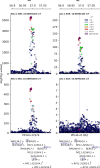Comparing the effects of CETP in East Asian and European ancestries: a Mendelian randomization study
- PMID: 38906890
- PMCID: PMC11192935
- DOI: 10.1038/s41467-024-49109-z
Comparing the effects of CETP in East Asian and European ancestries: a Mendelian randomization study
Abstract
CETP inhibitors are a class of lipid-lowering drugs in development for treatment of coronary heart disease (CHD). Genetic studies in East Asian ancestry have interpreted the lack of CETP signal with low-density lipoprotein cholesterol (LDL-C) and lack of drug target Mendelian randomization (MR) effect on CHD as evidence that CETP inhibitors might not be effective in East Asian participants. Capitalizing on recent increases in sample size of East Asian genetic studies, we conducted a drug target MR analysis, scaled to a standard deviation increase in high-density lipoprotein cholesterol. Despite finding evidence for possible neutral effects of lower CETP levels on LDL-C, systolic blood pressure and pulse pressure in East Asians (interaction p-values < 1.6 × 10-3), effects on cardiovascular outcomes were similarly protective in both ancestry groups. In conclusion, on-target inhibition of CETP is anticipated to decrease cardiovascular disease in individuals of both European and East Asian ancestries.
© 2024. The Author(s).
Conflict of interest statement
AFS and CF have received unrestricted funding from New Amsterdam Pharma, which is currently developing the CETP-inhibitor obicetrapib. The views expressed in this study are the personal views of MGM and do not represent the views of her current employer, the European Medicines Agency. All the authors declare no other competing interests.
Figures





References
-
- Lincoff, A. M. et al. Evacetrapib and cardiovascular outcomes in high-risk vascular disease. New Engl. J. Med.376, 1933–1942 (2017). - PubMed
Publication types
MeSH terms
Substances
Grants and funding
LinkOut - more resources
Full Text Sources
Medical

